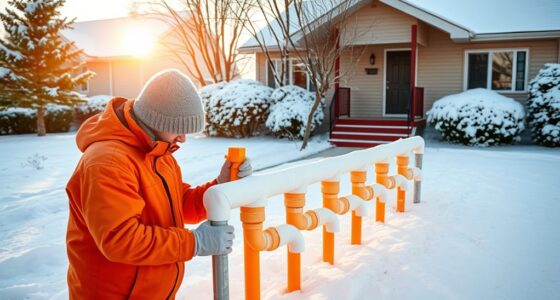To fix squeaky floors quickly, start by locating the exact source of the noise with gentle walk-overs and listen carefully. Tighten loose nails or fasteners using a hammer or replace them with screws for a stronger hold. You can also add shims or reinforce weak joists with additional supports. These straightforward fixes often solve the problem in no time, and there’s more you can do to keep your floors quiet for good if you keep exploring these simple tips.
Key Takeaways
- Locate squeak sources by walking and listening, then target the specific areas for quick repairs.
- Secure loose floorboards with wood screws or nails, applying a screwdriver or hammer for a tight fit.
- Add shims or small wedges between joists and subfloor to stabilize movement and reduce squeaks.
- Use construction adhesive and fasteners to reinforce loose joints and prevent future squeaks.
- Regularly inspect and tighten fasteners or add supports to maintain a quiet, squeak-free floor.

Squeaky floors can disrupt the comfort of your home, but fixing them doesn’t have to be complicated or costly. Often, the root of the noise comes down to floor joist issues or loose nails, both of which are manageable with some straightforward repairs. When your floors squeak, it’s usually because the wood parts rub against each other or move slightly when walked on. To start, you need to identify where the squeaks originate, which might involve walking around and listening carefully or even having someone else walk while you observe underneath if possible. Once you pinpoint the problem spots, you can address the issues directly.
One of the most common causes of squeaky floors is loose nails or fasteners. Over time, nails can work their way out or become loose, creating that telltale squeak. In such cases, nail tightening techniques are your best tools. You’ll want to carefully lift the affected floorboard, if possible, or work from underneath if access is available. Using a hammer and a nail set, tap the nails further in or replace them with new, longer nails to ensure they hold firmly. Be cautious not to drive the nails too deep, as that can cause splitting. Alternatively, you can use screws instead of nails for a more secure hold, especially if you’re dealing with persistent squeaks. When doing this, pre-drill small pilot holes to prevent splitting and ensure the screws seat tightly.
Tighten loose nails or replace with longer screws to stop squeaks effectively.
Another common issue is with the floor joists, the beams supporting your flooring. If these are sagging or have shifted, they can cause movement that results in squeaks. To address this, you might need to reinforce the joists. This can be done by adding sister joists—additional pieces of wood bolted alongside the existing ones—or installing shims to stabilize the structure. If the problem is severe, it might require more extensive repairs, but often, simply tightening the connections between joists and subfloor can noticeably reduce squeaks. Using construction adhesive along with nails or screws can also help secure loose boards and reduce movement. Additionally, inspecting air leaks that may be causing movement can help prevent future squeaks and improve overall stability.
In many cases, quick fixes like tightening nails and ensuring the floor joists are properly supported can restore peace and quiet to your home. These solutions are accessible and don’t require professional help unless the damage is extensive. Regular maintenance, such as checking for loose fasteners and reinforcing weak joists, can prevent future squeaks. With a little effort and the right tools, you’ll be able to silence those annoying noises and enjoy your quiet, comfortable home again.
Frequently Asked Questions
Can I Fix Squeaky Floors Without Professional Help?
Yes, you can fix squeaky floors yourself with some DIY tips. Start by identifying the squeaky spots and sprinkle talcum powder or powdered graphite between the floorboards to reduce friction. Secure loose boards with finish nails or screws, but be careful not to damage the flooring. This simple home improvement trick can often solve the problem without professional help, saving you time and money.
How Long Do DIY Squeaky Floor Repairs Last?
Think of your DIY squeaky floor repair as a temporary truce with a stubborn foe. It usually lasts several months to a few years, depending on how well you apply lubricant to the floor joist and tighten loose boards. If you keep up with these quick fixes, you can extend its peace treaty. Regular maintenance and re-lubrication can keep the squeak quiet for a surprisingly long time.
Are There Eco-Friendly Solutions for Squeaky Floors?
Yes, you can use eco-friendly materials and sustainable solutions to fix squeaky floors. Consider using natural fiber powders like talc or cork dust, which are non-toxic and environmentally friendly. You might also opt for biodegradable wood fillers or adhesives made from renewable resources. These options reduce your environmental impact while effectively addressing squeaks, making your repair both sustainable and safe for your home and planet.
What Tools Are Needed for Quick Squeaky Floor Fixes?
A stitch in time saves nine, so gather your tool essentials for quick squeaky floor fixes. You’ll need a screwdriver or drill to tighten loose floorboards, a hammer for tapping nails in, and a putty knife for filling gaps. A pry bar can help lift boards if needed. With these tools, you’re ready for simple floor repair, making your floors quiet again and saving you from bigger repairs later.
Will Fixing Squeaky Floors Damage My Warranty?
Fixing squeaky floors generally won’t damage your warranty if you follow proper repair procedures. However, rushing or using improper tools can increase repair risks, potentially voiding warranty coverage. To stay safe, check your warranty terms before making repairs and consider consulting a professional if you’re unsure. Being cautious and using recommended methods helps prevent any warranty implications and ensures your repairs are effective without risking harm.
Conclusion
With these quick fixes, you can silence those annoying squeaks and restore the peaceful rhythm of your home. Imagine walking barefoot across your floors, each step steady and silent, like a gentle whisper. By tightening, shimming, or adding lubricant, you bring harmony back beneath your feet. Soon, every step feels smooth and quiet, transforming your space into a tranquil retreat where squeaks are just distant echoes of a peaceful, squeak-free sanctuary.










